Effects of Ratoon Rice Cropping Patterns on Greenhouse Gas Emissions and Yield in Double-Season Rice Regions
Abstract
:1. Introduction
2. Results
2.1. Crop Grain Yield
2.2. CH4 Emission
2.3. N2O Emission
2.4. CO2 Emission
2.5. The GWP and Yield-Scaled GWP
3. Discussion
3.1. Impacts of Different Rice Paddy Cropping Patterns on Grain Yield
3.2. Impacts of Different Rice Paddy Cropping Patterns on Greenhouse Gas Emissions
3.3. Impacts of Different Rice Paddy Cropping Patterns on GWP and Yield-Scaled GWP
3.4. Uncertainty and Limitation
4. Materials and Methods
4.1. Experimental Site
4.2. Experimental Design and Agronomic Management
4.3. Sample Collection and Analysis
4.4. Calculation of GWP and Yield-Scaled GWP
4.5. Data Analysis
5. Conclusions
Author Contributions
Funding
Data Availability Statement
Acknowledgments
Conflicts of Interest
References
- Savage, K.; Phillips, R.; Davidson, E. High temporal frequency measurements of greenhouse gas emissions from soils. Biogeosciences 2014, 11, 2709–2720. [Google Scholar] [CrossRef]
- Montzka, S.A.; Dlugokencky, E.J.; Butler, J.H. Non-CO2 greenhouse gases and climate change. Nature 2011, 476, 43–50. [Google Scholar] [CrossRef]
- Dottori, F.; Szewczyk, W.; Ciscar, J.-C.; Zhao, F.; Alfieri, L.; Hirabayashi, Y.; Bianchi, A.; Mongelli, I.; Frieler, K.; Betts, R.A.; et al. Increased human and economic losses from river flooding with anthropogenic warming. Nat. Clim. Change 2018, 8, 781–786. [Google Scholar] [CrossRef]
- Li, Y.; Shang, J.; Zhang, C.; Zhang, W.; Niu, L.; Wang, L.; Zhang, H. The role of freshwater eutrophication in greenhouse gas emissions: A review. Sci. Total Environ. 2021, 768, 144582. [Google Scholar] [CrossRef] [PubMed]
- Xu, Y.; Ge, J.; Tian, S.; Li, S.; Nguy-Robertson, A.L.; Zhan, M.; Cao, C. Effects of water-saving irrigation practices and drought resistant rice variety on greenhouse gas emissions from a no-till paddy in the central lowlands of China. Sci. Total Environ. 2015, 505, 1043–1052. [Google Scholar] [CrossRef]
- Li, D.; He, H.; Zhou, G.; He, Q.; Yang, S. Rice yield and greenhouse gas emissions due to biochar and straw application under optimal reduced N fertilizers in a double season rice cropping system. Agronomy 2023, 13, 1023. [Google Scholar] [CrossRef]
- Tang, H.; Li, C.; Shi, L.; Cheng, K.; Wen, L.; Li, W.; Xiao, X. Effects of short-term tillage managements on CH4 and N2O emissions from a double-cropping rice field in southern of China. Agronomy 2022, 12, 517. [Google Scholar] [CrossRef]
- Zhang, J.; Tian, H.; Shi, H.; Zhang, J.; Wang, X.; Pan, S.; Yang, J. Increased greenhouse gas emissions intensity of major croplands in China: Implications for food security and climate change mitigation. Glob. Change Biol. 2020, 26, 6116–6133. [Google Scholar] [CrossRef]
- FAOSTAT. Food and Agriculture Organization of the United Nations Statistics Decision. 2020. Available online: http://www.fao.org/faostat/en/#data/QC/visualize (accessed on 10 October 2021).
- Hussain, S.; Peng, S.; Fahad, S.; Khaliq, A.; Huang, J.; Cui, K.; Nie, L. Rice management interventions to mitigate greenhouse gas emissions: A review. Environ. Sci. Pollut. R 2015, 22, 3342–3360. [Google Scholar] [CrossRef]
- Zhang, G.; Huang, Q.; Song, K.; Yu, H.; Ma, J.; Xu, H. Responses of greenhouse gas emissions and soil carbon and nitrogen sequestration to field management in the winter season: A 6-year measurement in a Chinese double-rice field. Agric. Ecosyst. Environ. 2021, 318, 107506. [Google Scholar] [CrossRef]
- Parry, M.L. Climate Change 2007-Impacts, Adaptation and Vulnerability. Working Group II Contribution to the Fourth Assessment Report of the IPCC; Cambridge University Press: Cambridge, UK, 2007; Volume 4. [Google Scholar]
- Zhang, Y.; Jiang, Y.; Tai, A.P.; Feng, J.; Li, Z.; Zhu, X.; Chen, J.; Zhang, J.; Song, Z.; Deng, A. Contribution of rice variety renewal and agronomic innovations to yield improvement and greenhouse gas mitigation in China. Enviro. Res. Lett. 2019, 14, 114020. [Google Scholar] [CrossRef]
- Chen, Y.; Zhang, Y.; Li, S.; Liu, K.; Li, G.; Zhang, D.; Lv, B.; Gu, J.; Zhang, H.; Yang, J. OsRGA1 optimizes photosynthate allocation for roots to reduce methane emissions and improve yield in paddy ecosystems. Soil Biol. Biochem. 2021, 160, 108344. [Google Scholar] [CrossRef]
- Ye, Q.; Yang, X.; Dai, S.; Chen, G.; Li, Y.; Zhang, C. Effects of climate change on suitable rice cropping areas, cropping systems and crop water requirements in southern China. Agric. Water Manag. 2015, 159, 35–44. [Google Scholar] [CrossRef]
- Sun, M.; Zhan, M.; Zhao, M.; Tang, L.L.; Qin, M.G.; Cao, C.G.; Cai, M.L.; Jiang, Y.; Liu, Z.H. Maize and rice double cropping benefits carbon footprint and soil carbon budget in paddy field. Field Crops Res. 2019, 243, 107620. [Google Scholar] [CrossRef]
- Gao, B.; Huang, T.; Ju, X.; Gu, B.; Huang, W.; Xu, L.; Rees, R.M.; Powlson, D.S.; Smith, P.; Cui, S. Chinese cropping systems are a net source of greenhouse gases despite soil carbon sequestration. Glob. Change Biol. 2018, 24, 5590–5606. [Google Scholar] [CrossRef] [PubMed]
- Wang, Y.; Zheng, C.; Xiao, S.; Sun, Y.; Huang, J.; Peng, S. Agronomic responses of ratoon rice to nitrogen management in central China. Field Crops Res. 2019, 241, 107569. [Google Scholar] [CrossRef]
- Dong, H.; Chen, Q.; Wang, W.; Peng, S.; Huang, J.; Cui, K.; Nie, L. The growth and yield of a wet-seeded rice-ratoon rice system in central China. Field Crops Res. 2017, 208, 55–59. [Google Scholar] [CrossRef]
- Yu, X.; Tao, X.; Liao, J.; Liu, S.; Xu, L.; Yuan, S.; Zhang, Z.; Wang, F.; Deng, N.; Huang, J. Predicting potential cultivation region and paddy area for ratoon rice production in China using Maxent model. Field Crops Res. 2022, 275, 108372. [Google Scholar] [CrossRef]
- Ren, X.; Cui, K.; Deng, Z.; Han, K.; Peng, Y.; Zhou, J.; Zhai, Z.; Huang, J.; Peng, S. Ratoon rice cropping mitigates the greenhouse effect by reducing CH4 emissions through reduction of biomass during the ratoon season. Plants 2023, 12, 3354. [Google Scholar] [CrossRef]
- Weller, S.; Janz, B.; Jörg, L.; Kraus, D.; Racela, H.S.; Wassmann, R.; Butterbach-Bahl, K.; Kiese, R. Greenhouse gas emissions and global warming potential of traditional and diversified tropical rice rotation systems. Glob. Change Biol. 2016, 22, 432–448. [Google Scholar] [CrossRef]
- Song, K.; Zhang, G.; Yu, H.; Huang, Q.; Zhu, X.; Wang, T.; Xu, H.; Lv, S.; Ma, J. Evaluation of methane and nitrous oxide emissions in a three-year case study on single rice and ratoon rice paddy fields. J. Clean. Prod. 2021, 297, 126650. [Google Scholar] [CrossRef]
- Shang, Q.; Yang, X.; Gao, C.; Wu, P.; Liu, J.; Xu, Y.; Shen, Q.; Zou, J.; Guo, S. Net annual global warming potential and greenhouse gas intensity in Chinese double rice-cropping systems: A 3-year field measurement in long-term fertilizer experiments. Glob. Change Biol. 2011, 17, 2196–2210. [Google Scholar] [CrossRef]
- Zhong, C.; Liu, Y.; Xu, X.; Yang, B.; Aamer, M.; Zhang, P.; Huang, G. Paddy-upland rotation with Chinese milk vetch incorporation reduced the global warming potential and greenhouse gas emissions intensity of double rice cropping system. Environ. Pollut. 2021, 276, 116696. [Google Scholar] [CrossRef]
- Lashof, D.A.; Ahuja, D.R. Relative contributions of greenhouse gas emissions to global warming. Nature 1990, 344, 529–531. [Google Scholar] [CrossRef]
- Mosier, A.R.; Halvorson, A.D.; Reule, C.A.; Liu, X.J. Net global warming potential and greenhouse gas intensity in irrigated cropping systems in northeastern Colorado. J. Environ. Qual. 2006, 35, 1584–1598. [Google Scholar] [CrossRef] [PubMed]
- Yuan, S.; Cassman, K.G.; Huang, J.; Peng, S.; Grassini, P. Can ratoon cropping improve resource use efficiencies and profitability of rice in central China? Field Crops Res. 2019, 234, 66–72. [Google Scholar] [CrossRef]
- Zhou, Y.; Ji, Y.; Zhang, M.; Xu, Y.; Li, Z.; Tu, D.; Wu, W. Exploring a sustainable rice-crop system to balance grain yield, environmental footprint and economic benefits in the middle and lower reaches of the Yangtze River in China. J. Clean. Prod. 2023, 404, 136988. [Google Scholar] [CrossRef]
- Wang, D.; Laza, M.R.C.; Cassman, K.G.; Huang, J.; Nie, L.; Ling, X.; Centeno, G.S.; Cui, K.; Wang, F.; Li, Y. Temperature explains the yield difference of double-season rice between tropical and subtropical environments. Field Crops Res. 2016, 198, 303–311. [Google Scholar] [CrossRef]
- Xu, Y.; Liang, L.; Wang, B.; Xiang, J.; Gao, M.; Fu, Z.; Long, P.; Luo, H.; Huang, C. Conversion from double-season rice to ratoon rice paddy fields reduces carbon footprint and enhances net ecosystem economic benefit. Sci. Total Environ. 2022, 813, 152550. [Google Scholar] [CrossRef]
- Jiang, Y.; van Groenigen, K.J.; Huang, S.; Hungate, B.A.; van Kessel, C.; Hu, S.; Zhang, J.; Wu, L.; Yan, X.; Wang, L. Higher yields and lower methane emissions with new rice cultivars. Glob. Change Biol. 2017, 23, 4728–4738. [Google Scholar] [CrossRef]
- Liu, D.; Ishikawa, H.; Nishida, M.; Tsuchiya, K.; Takahashi, T.; Kimura, M.; Asakawa, S. Effect of paddy-upland rotation on methanogenic archaeal community structure in paddy field soil. Microb. Ecol. 2015, 69, 160–168. [Google Scholar] [CrossRef] [PubMed]
- Yin, X.; Peñuelas, J.; Sardans, J.; Xu, X.; Chen, Y.; Fang, Y.; Wu, L.; Singh, B.P.; Tavakkoli, E.; Wang, W. Effects of nitrogen-enriched biochar on rice growth and yield, iron dynamics, and soil carbon storage and emissions: A tool to improve sustainable rice cultivation. Environ. Pollut. 2021, 287, 117565. [Google Scholar] [CrossRef] [PubMed]
- Janz, B.; Weller, S.; Kraus, D.; Racela, H.S.; Wassmann, R.; Butterbach-Bahl, K.; Kiese, R. Greenhouse gas footprint of diversifying rice cropping systems: Impacts of water regime and organic amendments. Agric. Ecosyst. Environ. 2019, 270, 41–54. [Google Scholar] [CrossRef]
- Estop-Aragonés, C.; Knorr, K.-H.; Blodau, C. Belowground in situ redox dynamics and methanogenesis recovery in a degraded fen during dry-wet cycles and flooding. Biogeosciences 2013, 10, 421–436. [Google Scholar] [CrossRef]
- Nicholson, F.A.; Bhogal, A.; Chadwick, D.; Gill, E.; Gooday, R.; Lord, E.; Misselbrook, T.; Rollett, A.; Sagoo, E.; Smith, K. An enhanced software tool to support better use of manure nutrients: MANNER-NPK. Soil Use Manag. 2013, 29, 473–484. [Google Scholar] [CrossRef]
- Kool, D.M.; Dolfing, J.; Wrage, N.; Van Groenigen, J.W. Nitrifier denitrification as a distinct and significant source of nitrous oxide from soil. Soil Biol. Biochem. 2011, 43, 174–178. [Google Scholar] [CrossRef]
- Yang, W.H.; The, Y.A.; Silver, W.L. A test of a field-based 15N–nitrous oxide pool dilution technique to measure gross N2O production in soil. Glob. Change Biol. 2011, 17, 3577–3588. [Google Scholar] [CrossRef]
- Zhu, Z.K.; Ge, T.D.; Luo, Y.; Liu, S.L.; Xu, X.L.; Tong, C.L.; Shibistova, O.; Guggenberger, G.; Wu, J.S. Microbial stoichiometric flexibility regulates rice straw mineralization and its priming effect in paddy soil. Soil Biol. Biochem. 2018, 121, 67–76. [Google Scholar] [CrossRef]
- Jiang, Z.; Lin, J.; Liu, Y.; Mo, C.; Yang, J. Double paddy rice conversion to maize–paddy rice reduces carbon footprint and enhances net carbon sink. J. Clean. Prod. 2020, 258, 120643. [Google Scholar] [CrossRef]
- Zhao, Y.; Wang, L.; Lei, X.; Wang, B.; Cui, J.; Xu, Y.; Chen, Y.; Sui, P. Reducing carbon footprint without compromising grain security through relaxing cropping rotation system in the North China Plain. J. Clean. Prod. 2021, 318, 128465. [Google Scholar] [CrossRef]
- Wood, J.D.; Gordon, R.J.; Wagner-Riddle, C. Biases in discrete CH4 and N2O sampling protocols associated with temporal variation of gas fluxes from manure storage systems. Agric. For. Meteorol. 2013, 171, 295–305. [Google Scholar] [CrossRef]
- Xu, Y.; Zhan, M.; Cao, C.; Tian, S.; Ge, J.; Li, S.; Wang, M.; Yuan, G. Improved water management to reduce greenhouse gas emissions in no-till rapeseed–rice rotations in Central China. Agric. Ecosyst. Environ. 2016, 221, 87–98. [Google Scholar] [CrossRef]
- Chen, Q.; He, A.; Wang, W.; Peng, S.; Huang, J.; Cui, K.; Nie, L. Comparisons of regeneration rate and yields performance between inbred and hybrid rice cultivars in a direct seeding rice-ratoon rice system in central China. Field Crops Res. 2018, 223, 164–170. [Google Scholar] [CrossRef]
- Huang, M.; Fang, S.; Cao, F.; Chen, J.; Shan, S.; Liu, Y.; Lei, T.; Tian, A.; Tao, Z.; Zou, Y. Early sowing increases grain yield of machine-transplanted late-season rice under single-seed sowing. Field Crops Res. 2020, 253, 107832. [Google Scholar] [CrossRef]
- Forster, P.; Storelvmo, T.; Armour, K.; Collins, W.; Dufresne, J.L.; Frame, D.; Lunt, D.J.; Mauritsen, T.; Palmer, M.D.; Watanabe, M.; et al. Chapter 7: The Earth’s energy budget, climate feedbacks, and climate sensitivity. In Climate Change 2021, The Physical Science Basis: Contribution of Working Group I to the Sixth Assessment Report of the Intergovernmental Panel on Climate Change; Cambridge University Press: Cambridge, UK, 2021. [Google Scholar]
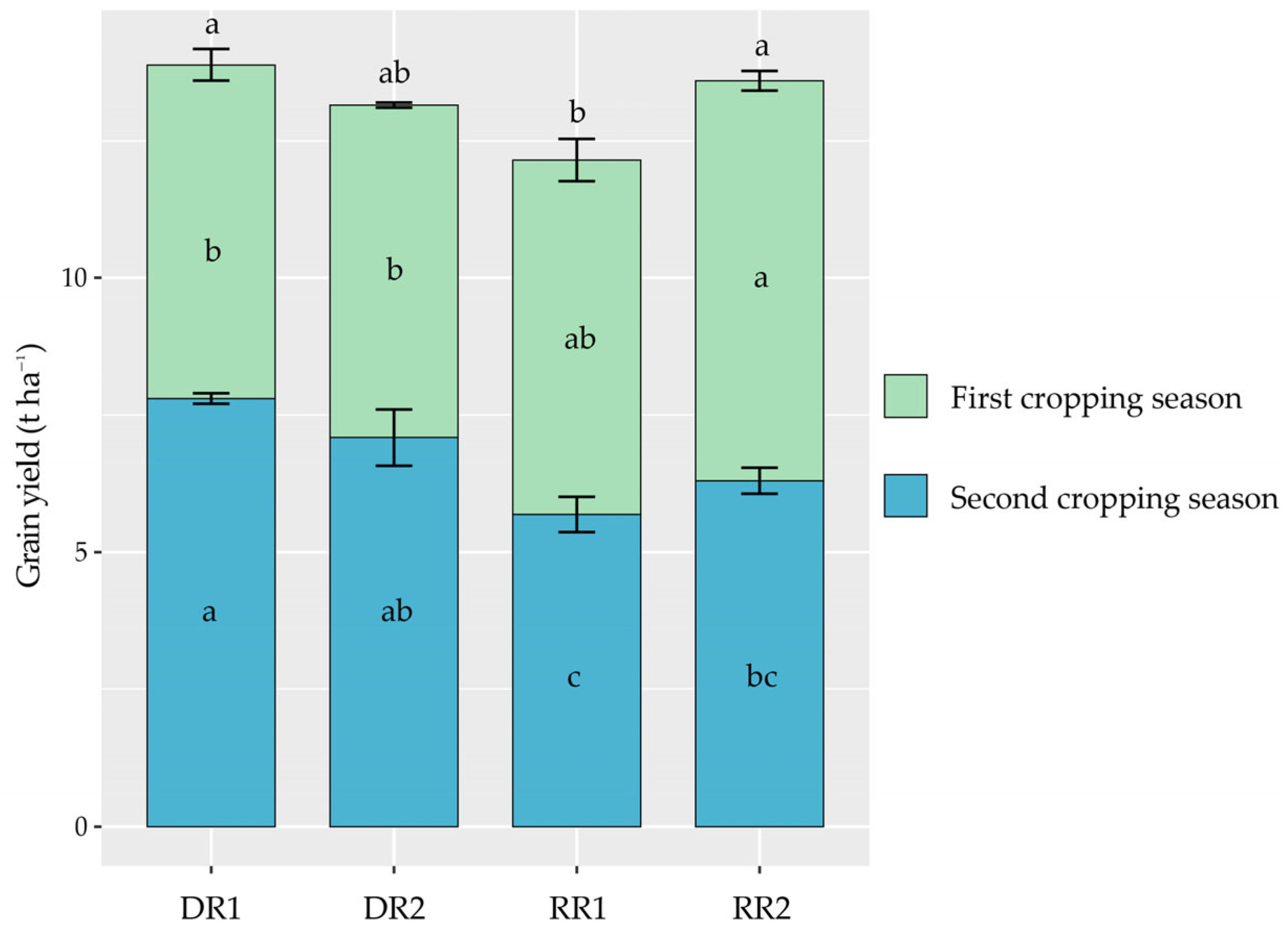
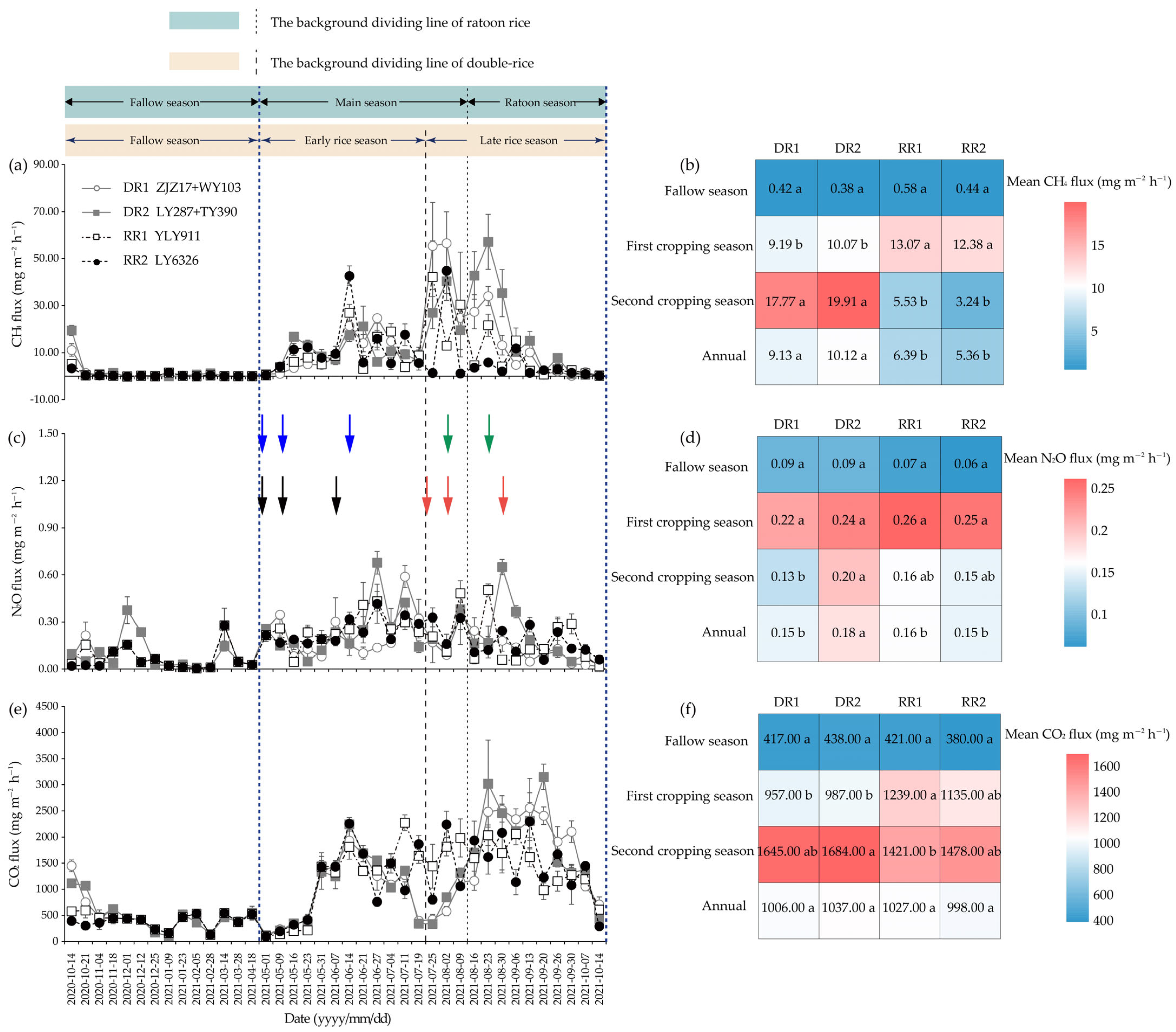

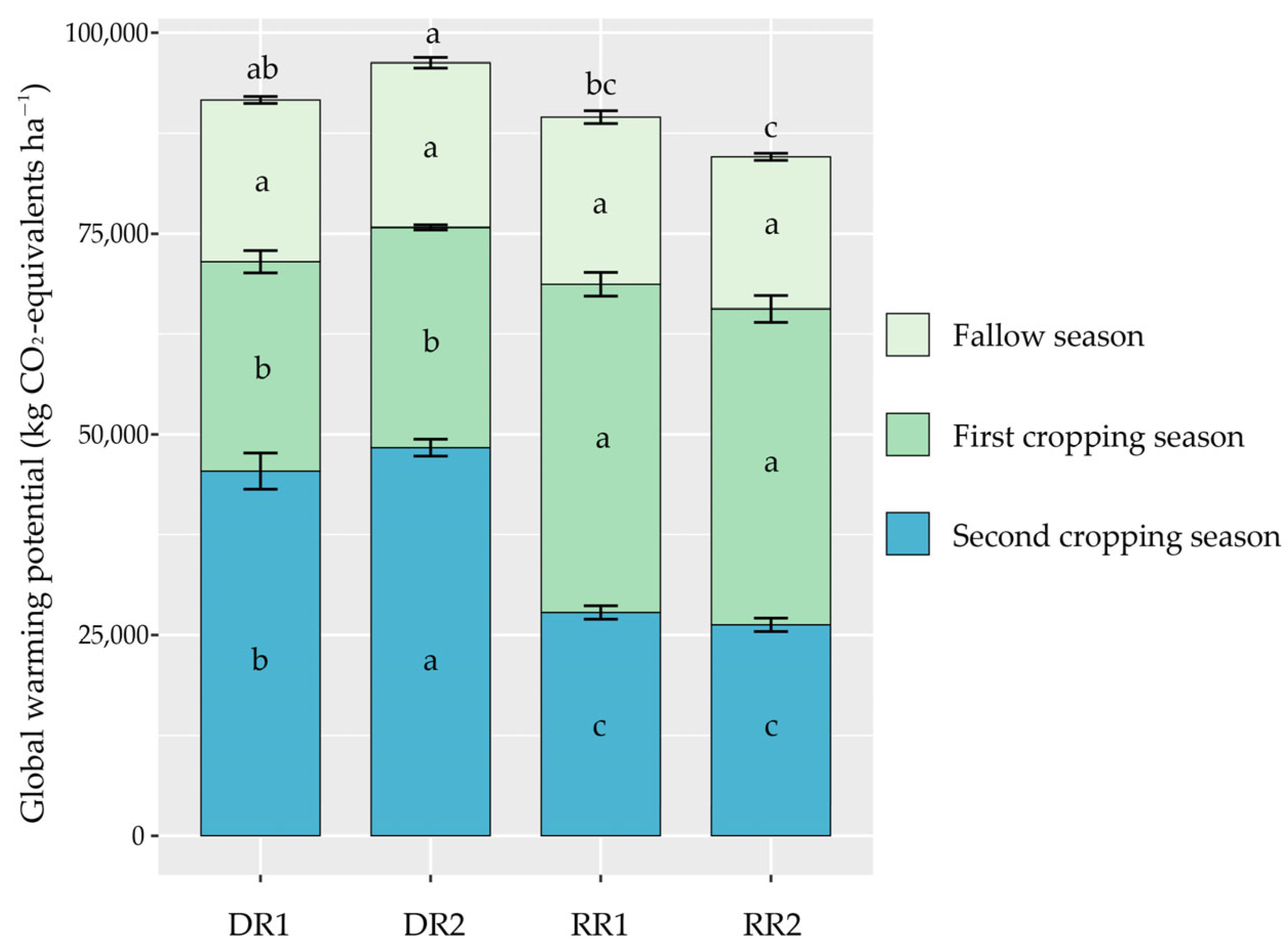
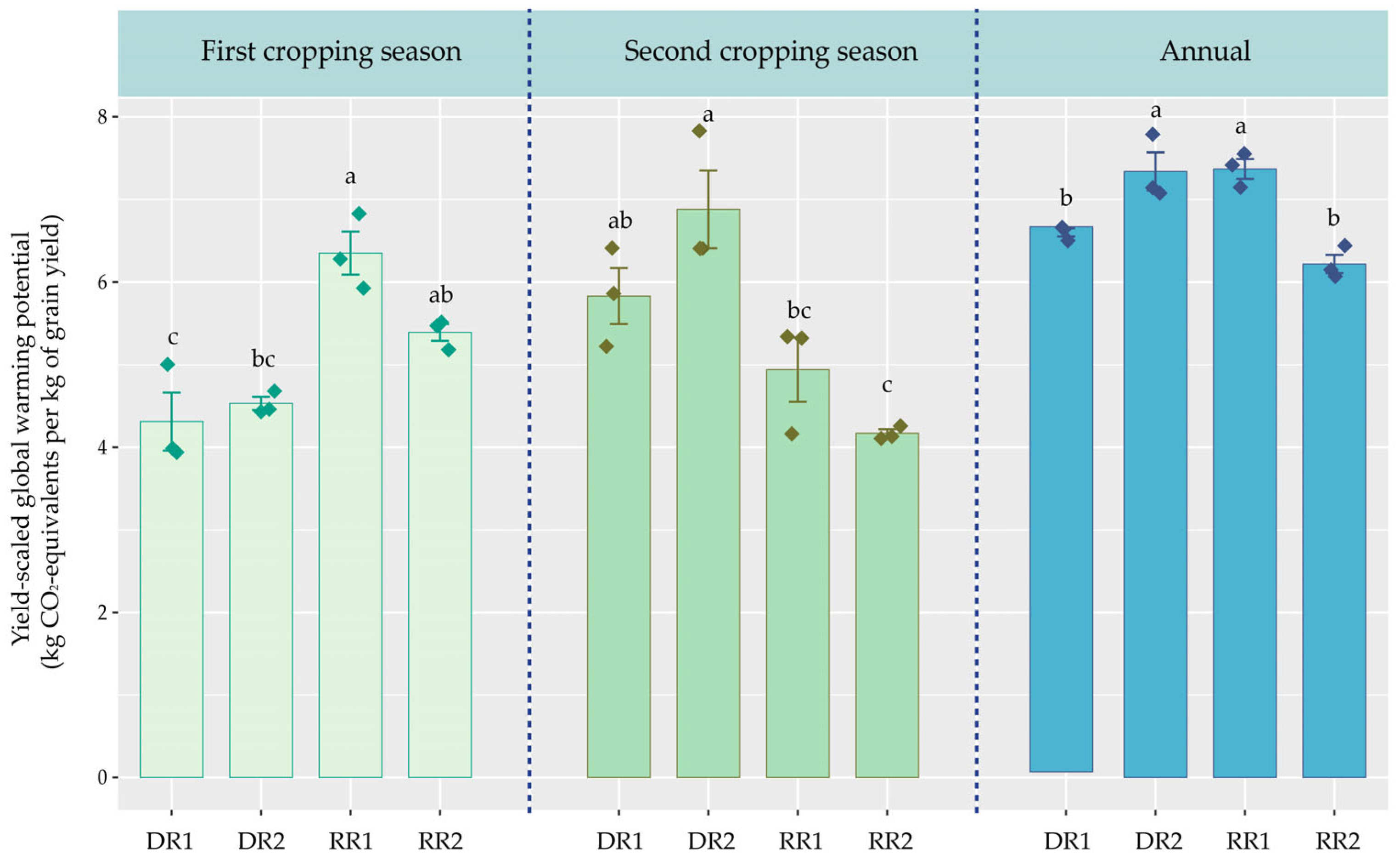

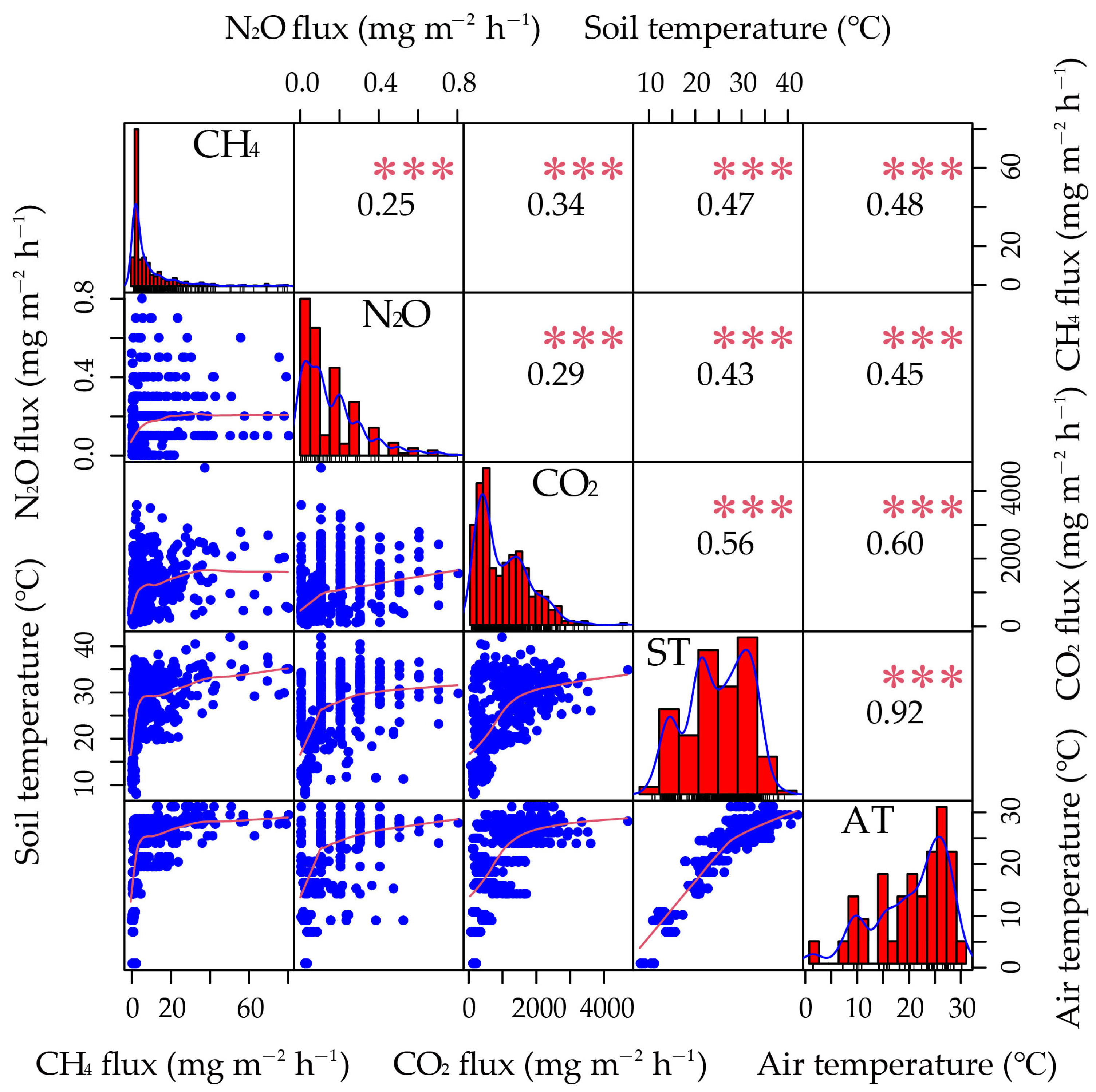
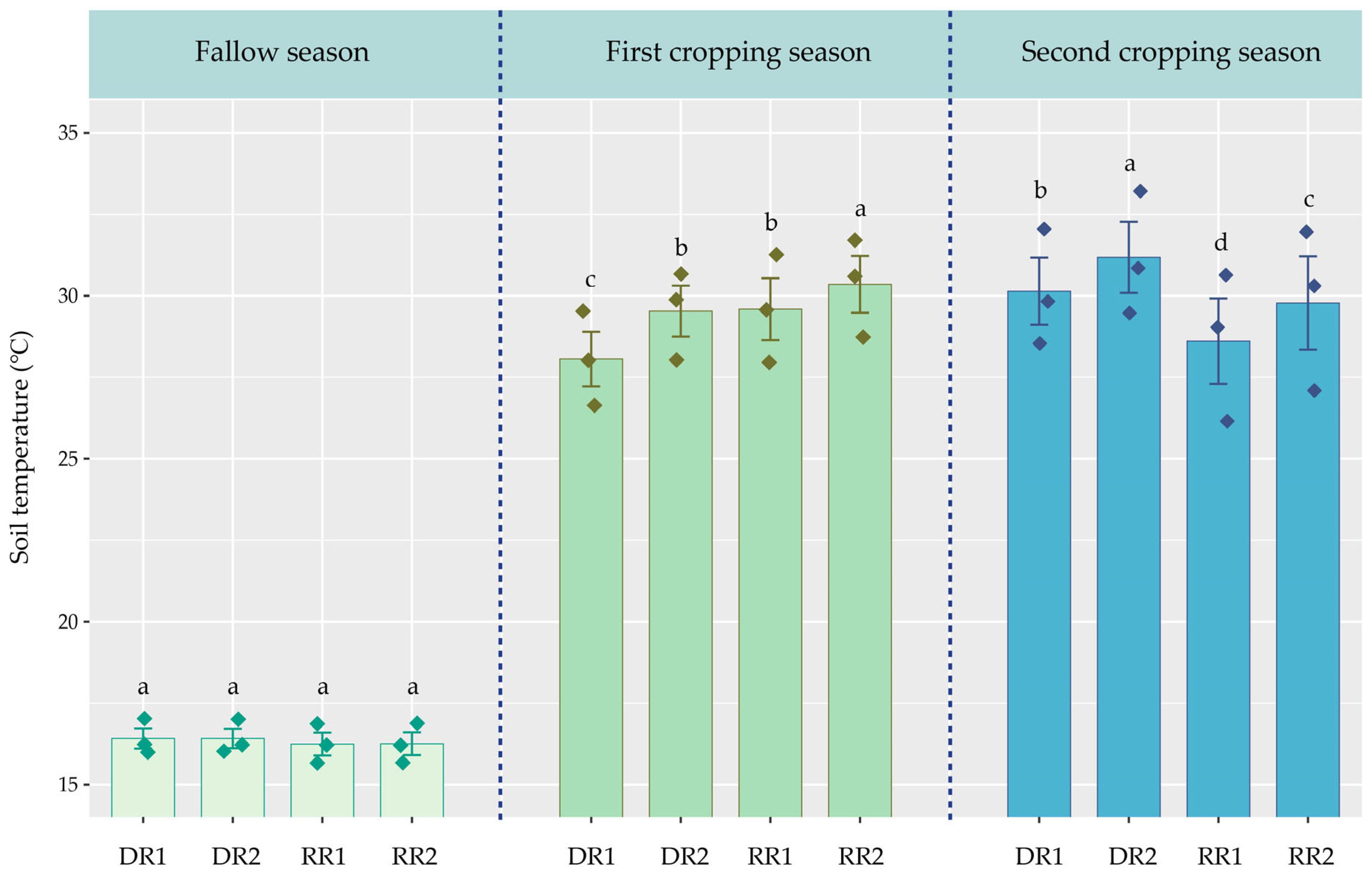
| Sources | Grain Yield | Mean CH4 Flux | Mean N2O Flux | Mean CO2 Flux | Cumulative CH4 Emission | Cumulative N2O Emission | Cumulative CO2 Emission | GWP | Yield-Scaled GWP |
|---|---|---|---|---|---|---|---|---|---|
| Season (S) | 7.69 ** 1 | 4.49 * | 31.23 ** | 0.23 ns | 26.39 ** | 51.80 ** | 20.18 ** | 23.69 ** | 2.57 ns |
| Cropping pattern (C) | 0.17 ns | 5.37 * | 0.18 ns | 0.00 ns | 4.72 * | 0.07 ns | 0.01 ns | 0.25 ns | 0.29 ns |
| Variety (V) | 0.05 ns | 0.00 ns | 0.43 ns | 0.00 ns | 0.00 ns | 0.07 ns | 0.00 ns | 0.00 ns | 0.20 ns |
| S × C | 0.47 ns | 4.48 * | 0.69 ns | 0.73 ns | 1.61 ns | 0.91 ns | 0.73 ns | 0.94 ns | 12.35 ** |
| S × V | 0.04 ns | 0.00 ns | 0.02 ns | 0.02 ns | 0.03 ns | 0.01 ns | 0.00 ns | 0.00 ns | 0.38 ns |
| C × V | 0.47 ns | 0.39 ns | 1.81 ns | 0.05 ns | 0.35 ns | 0.69 ns | 0.07 ns | 0.12 ns | 6.19 * |
| S × C × V | 0.00 ns | 0.01 ns | 0.02 ns | 0.02 ns | 0.00 ns | 0.02 ns | 0.01 ns | 0.01 ns | 0.05 ns |
| Cropping Patterns 1 | Crop Season | Varieties 2 | Dates of Sowing-Transplanting-Harvest, mm/dd (Days) |
|---|---|---|---|
| DR | First crop season | ZJZ17 | 3/23-4/30-7/17 (116) |
| LY287 | 3/23-4/30-7/17 (116) | ||
| Second crop season | WY103 | 6/25-7/23-10/10 (107) | |
| TY390 | 6/25-7/23-10/10 (107) | ||
| RR | First crop season | YLY911 | 3/23-4/30-8/9 (139) |
| LY6326 | 3/23-4/30-8/9 (139) | ||
| Second crop season | YLY911 | /-/-10/9 (61) | |
| LY6326 | /-/-10/9 (61) |
Disclaimer/Publisher’s Note: The statements, opinions and data contained in all publications are solely those of the individual author(s) and contributor(s) and not of MDPI and/or the editor(s). MDPI and/or the editor(s) disclaim responsibility for any injury to people or property resulting from any ideas, methods, instructions or products referred to in the content. |
© 2024 by the authors. Licensee MDPI, Basel, Switzerland. This article is an open access article distributed under the terms and conditions of the Creative Commons Attribution (CC BY) license (https://creativecommons.org/licenses/by/4.0/).
Share and Cite
Xiang, J.; Zhong, L.; Yuan, Z.; Liang, L.; Yang, Z.; Xiao, Y.; Fu, Z.; Long, P.; Huang, C.; Xu, Y. Effects of Ratoon Rice Cropping Patterns on Greenhouse Gas Emissions and Yield in Double-Season Rice Regions. Plants 2024, 13, 1527. https://doi.org/10.3390/plants13111527
Xiang J, Zhong L, Yuan Z, Liang L, Yang Z, Xiao Y, Fu Z, Long P, Huang C, Xu Y. Effects of Ratoon Rice Cropping Patterns on Greenhouse Gas Emissions and Yield in Double-Season Rice Regions. Plants. 2024; 13(11):1527. https://doi.org/10.3390/plants13111527
Chicago/Turabian StyleXiang, Jinbiao, Liusheng Zhong, Zhixiong Yuan, Liqin Liang, Zhangzhen Yang, Yanmei Xiao, Zhiqiang Fu, Pan Long, Cheng Huang, and Ying Xu. 2024. "Effects of Ratoon Rice Cropping Patterns on Greenhouse Gas Emissions and Yield in Double-Season Rice Regions" Plants 13, no. 11: 1527. https://doi.org/10.3390/plants13111527
APA StyleXiang, J., Zhong, L., Yuan, Z., Liang, L., Yang, Z., Xiao, Y., Fu, Z., Long, P., Huang, C., & Xu, Y. (2024). Effects of Ratoon Rice Cropping Patterns on Greenhouse Gas Emissions and Yield in Double-Season Rice Regions. Plants, 13(11), 1527. https://doi.org/10.3390/plants13111527





